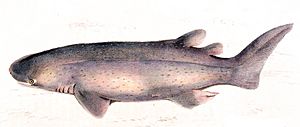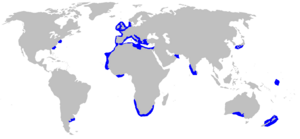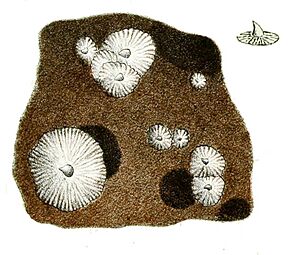Bramble shark facts for kids
Quick facts for kids Bramble shark |
|
|---|---|
 |
|
| Echinorhinus brucus, illustration of the zoology of South Africa (1838) | |
 |
|
| Echinorhinus brucus, mounted specimen. | |
| Conservation status | |
| Scientific classification | |
| Genus: |
Echinorhinus
|
| Species: |
brucus
|
 |
|
| Range of the bramble shark | |
| Synonyms | |
|
Echinorhinus mccoyi Whitley, 1931 |
|
The bramble shark (Echinorhinus brucus) is a fascinating deep-sea shark. It's one of only two types of sharks in its family, called Echinorhinidae. You can find this shark in tropical and temperate waters all over the world, except for the eastern Pacific Ocean.
This shark is rarely seen because it lives deep down near the ocean floor. It usually swims at depths of about 400 to 900 meters (1,300 to 3,000 feet). Sometimes, it might come into shallower waters. The bramble shark has a strong, thick body with two small fins on its back, placed very far back. It doesn't have an anal fin (a fin on its underside near the tail).
One of the easiest ways to spot a bramble shark is by the large, thorn-like bumps all over its body. Some of these bumps might even be joined together. Its skin is usually purplish-brown or black. This shark can grow up to 3.1 meters (10 feet) long!
Bramble sharks are slow swimmers. They eat smaller sharks, other fish, and crabs. They might even use suction to catch their food! Female bramble sharks give birth to live young, usually between 15 and 52 pups at a time.
These sharks are not harmful to humans. Sometimes, they get caught by accident by fishing boats. People might use them for fishmeal or for their liver oil. Sadly, the number of bramble sharks in the northeastern Atlantic Ocean has dropped a lot since the 1700s and 1800s. This is probably because too many were caught by fishing.
Contents
What is a Bramble Shark?
The bramble shark was first described by a French naturalist named Pierre Joseph Bonnaterre in 1788. He named it Squalus brucus. The name brucus comes from an ancient Greek word meaning "from the depths of the sea." Later, in 1816, another scientist named Henri de Blainville created the genus Echinorhinus just for this shark.
For a long time, people confused the bramble shark with another shark called the prickly shark (E. cookei). This happened with sharks caught in the Pacific Ocean until the 1960s. Other common names for the bramble shark include "spinous shark" and "spiny shark."
How to Identify a Bramble Shark
The bramble shark has a thick, round body and a head that is a bit flat. Its snout is blunt and shorter than its wide mouth. It has nostrils that are far apart, with small skin flaps in front of them. The eyes don't have special eyelids, and its tiny breathing holes (spiracles) are located behind the eyes.
Its wide, curved mouth has very short grooves at the corners. Inside, it has many rows of knife-like teeth. Each tooth has one main point and up to three smaller points on each side. It has five pairs of gill slits, which are openings for breathing, with the last pair being the longest.
The fins on its chest (pectoral fins) are short and angled. The fins on its belly (pelvic fins) are long and quite large. The two fins on its back (dorsal fins) are small. The first dorsal fin starts behind the pelvic fins. Remember, it doesn't have an anal fin. The part of its body leading to the tail (caudal peduncle) is strong and smooth. The tail fin itself is not symmetrical, with a less clear lower part and an upper part without a notch.
The skin of a bramble shark is covered in a thick, smelly slime. The thorn-like bumps on its skin are scattered unevenly and vary a lot in size. They can be up to 1.5 centimeters (0.6 inches) wide. Each bump looks like a thorn with ridges spreading out from its center. Sometimes, up to ten of these bumps can join together to form larger, multi-pointed plates.
Younger sharks have many small bumps under their snout and around their mouth. As they grow bigger, these bumps become larger and more spread out. The shark is usually brown to black on top, with a shiny purplish color, and lighter underneath. Some sharks might even have red or black spots. There's even a report of one shark that glowed green when it was just caught!
The bramble shark can grow to about 3.1 meters (10 feet) long. The heaviest one ever recorded was a female that weighed 200 kilograms (440 pounds) and was 2.8 meters (9.2 feet) long.
Where Bramble Sharks Live
Bramble sharks are quite rare, and they've been found in many different places around the world. They live in tropical and temperate waters everywhere except the eastern Pacific Ocean. Most sightings have been in the eastern Atlantic Ocean and western Indian Ocean. Their range stretches from the North Sea and British Isles all the way to southern Mozambique, including the Mediterranean Sea.
In the western Atlantic, only a few bramble sharks have been found. These were in places like Massachusetts, North Carolina, Louisiana, Tobago, Brazil, and Argentina. In the Indo-Pacific region, they've been seen off the coasts of Oman, India, southern Japan, southern Australia, New Zealand, and possibly Kiribati.
These sharks live close to the ocean floor, usually on continental and island shelves and slopes. They are most commonly found at depths of 400 to 900 meters (1,300 to 3,000 feet). However, they have been seen in waters as shallow as 18 meters (59 feet) where cold water rises to the surface. They can also live as deep as 1,214 meters (3,983 feet). In European waters, these sharks might move into shallower areas (20 to 200 meters or 66 to 656 feet) during the summer.
Bramble Shark Diet and Reproduction
Bramble sharks are slow-moving creatures. They eat smaller sharks, like the spiny dogfish, and various bony fish, such as ling, catfish, and lizardfish. They also enjoy eating crabs. Because their throat is very large compared to their mouth, scientists think they might catch their food by sucking it in.
These sharks give birth to live young, which means the pups develop inside the mother's body without a placenta. Female bramble sharks have two working ovaries and two uteruses. The number of pups in a litter can range from 15 to 52. When they are born, the pups are estimated to be about 40 to 50 centimeters (16 to 20 inches) long.
The thorn-like bumps on the skin of baby sharks that are still inside their mother are not fully developed. They look like tiny spines hidden in open pits in the skin. Scientists are not sure exactly when bramble sharks become old enough to reproduce. The smallest known mature males were about 1.5 meters (4.9 feet) long, and the smallest mature females were about 2.1 meters (6.9 feet) long.
Bramble Sharks and Humans
Bramble sharks are not known to be dangerous to people. They are sometimes caught by accident by large fishing boats using nets that drag along the bottom (bottom trawls) or by people fishing with lines. Sport fishermen also sometimes catch them.
In the eastern Atlantic, these sharks are sometimes used to make fishmeal, but they are not a very important fish for business. In South Africa, their liver oil is highly valued as medicine. However, in India, the oil is thought to be of poor quality and is used to coat canoes to stop wood-boring beetles.
Old records show that the number of bramble sharks in the northeastern Atlantic has gone down a lot since the 1700s and 1800s. Now, they are very rare off northern Europe and in the Mediterranean Sea. This decline is likely due to fishing. Large, deep-sea sharks like the bramble shark grow slowly and live for a long time, which makes them very vulnerable to overfishing.
Because of this, the International Union for Conservation of Nature (IUCN) has listed the bramble shark as an Endangered species. In June 2018, New Zealand's Department of Conservation also classified the bramble shark as "At Risk – Naturally Uncommon."
Images for kids
See also
 In Spanish: Pez clavo para niños
In Spanish: Pez clavo para niños










